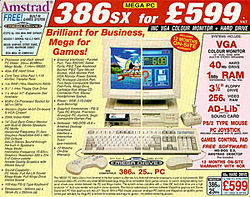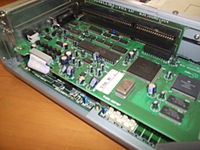- Amstrad Mega PC
-
Amstrad Mega PC Manufacturer Amstrad (licensed by Sega) Generation Fourth generation (16-bit era) Retail availability  1993
1993
 1993
1993Media Cartridge, Diskette CPU 32-bit Intel 80386 Storage capacity Hard Drive, Floppy Disk The Mega PC was manufactured and released by Amstrad in 1993 under licence from Sega. It was similar, but unrelated to the Sega TeraDrive. Essentially just a standard Amstrad PC with Sega Mega Drive hardware bundled inside, the system was wired to share the dual-sync monitor and speakers, with the Mega Drive on a separate circuit board.[1]
Initially released in PAL areas such as Europe and Australia in 1993,[2] its success was very short-lived due to its very high retail price of £999.99 (later reduced to £599), with the CPU also being outdated by the time of the system's release. It is slightly easier and cheaper to acquire an Amstrad Mega PC in Europe due to more units being manufactured, than it is to acquire a Sega TeraDrive elsewhere. In recent years, both systems have increasingly become relatively difficult to come by, as they are owned and often purchased by many as collector's items.
Contents
Technical specifications
Specifications Processor Intel 80386 @ 25 MHz
Motorola 68000 @ 7.14 MHzMemory 1MB SIMM RAM (expandable to 16MB) Storage 3.5" FDD, 40MB HDD Video SVGA Graphics with 256KB RAM Operating System MS DOS 5.0 with Amstrad Desktop Dimensions 325 mm(w) x 78 mm(h) x 292 mm(d) Power Usage ~50W In general, the Mega PC was seen as a nicer build than that of Sega's TeraDrive, as the unit itself was more robust and managed air circulation more efficiently than the TeraDrive.[3]
The machine shipped with 1MB of RAM, provided by 4× 256KB 30-pin SIMM sticks. This was expandable to 16MB by using 4× 4MB memory modules.[4]
Although it boasted a higher specification than the Sega TeraDrive (having more RAM and a faster processor), the specification of the CPU, similarly to Sega's TeraDrive, was a generation behind its time, with the newer Intel 80486 on the market and the first Pentium processors being released the same year as the Mega PC was. The system was unable to act as a Software Development Kit due to the inability to simultaneously use the PC and the Mega Drive hardware. A cover on the front of the unit prevented the insertion of a Mega Drive game cartridge while using with the PC hardware.[5]
Input/Output
The machine's rear housed several I/O ports. These included two COM ports, a 25-pin LPT port, a VGA port with combined signals for a standard VGA monitor and sound (Amstrad monitor only), a speaker/headphone jack, and a 15 pin game port for a joystick .
The motherboard included a 16 bit ISA slot with a riser card connected to it, providing a total of two 16 bit ISA slots. One of these was populated with an ISA card which provided connections for sound at the rear of the machine, and a connection for the Mega Drive cartridge at the front. The other slot was left free for expansion (such as a modem or Network Interface Card).[4]
Whereas the Sega TeraDrive included stereo RCA jacks and composite NTSC video output for connection to a TV, the Mega PC lacked this feature, and thus lacked the ability to connect to a television set.[5] This is more than likely because the Mega PC was designed to only allow 1 section of the unit to be used at any given time, so to provide the ability for a 2nd video output wouldn't have been worthwhile. Therefore, outputs from both the PC and Mega Drive units was available only through the SVGA connector to the supplied dual-sync (15 kHz/31 kHz) monitor.[1]
Compatibility
Although shipping with an Amstrad branded controller, the wiring was identical to that of Sega's controllers, thus could be used on either system.
Peripherals
Amstrad bundled several peripherals with its Mega PC; these included:
- Dual sync 15 kHz/31 kHz Amstrad branded 14" white monitor with internal speakers
- Standard Mega Drive white control pad with Amstrad branding
- Amstrad white joystick
- Standard Amstrad keyboard and mouse using PS/2 interface
Mega Plus
Amstrad later released a second system as the successor to the Mega PC, by the name of the Amstrad Mega Plus. This boasted a slightly higher specification with an upgraded processor to an Intel 80486 running at 33 MHz, along with a RAM upgrade of 4× 1MB SIMM sticks to 4MB.[6]
See also
References
- ^ a b "Amstrad MegaPC @". Everything2.com. 2000-10-29. http://www.everything2.com/index.pl?node_id=810824. Retrieved 2010-05-30.
- ^ [1][dead link]
- ^ "Assembler: Page 3 (via Archive.org)". Web.archive.org. 2008-05-23. Archived from the original on 2008-05-23. http://web.archive.org/web/20080523123514/http://assembler.roarvgm.com/Amstrad_megadrive_computer_1/Amstrad_megadrive_3/amstrad_megadrive_3.html. Retrieved 2010-05-30.
- ^ a b "Amstrad Mega PC Service manual" (PDF). http://www.amstradcg.nl/mega.pdf. Retrieved 2010-05-30.
- ^ a b "Assembler: Page 1 (via Archive.org)". Web.archive.org. Archived from the original on 2008-06-14. http://web.archive.org/web/20080614215246/http://assembler.roarvgm.com/Amstrad_megadrive_computer_1/amstrad_megadrive_computer_1.html. Retrieved 2010-05-30.
- ^ "1000 BiT +- Computer's description". 1000bit.net. http://www.1000bit.net/scheda.asp?id=2038. Retrieved 2010-05-30.
External links
- http://www.uk.playright.dk/raretitel.php?id=13883
- Amstrad Mega PC article at Assembler (via Archive.org)
Sega Sega Studios Global Entertainment · New Entertainment · Sega Sports Japan · Sega Wow · Sega AM2 · Sega AM3 · Wave Master · The Creative Assembly · Sports InteractiveConsoles SG-1000/SG-1000 II · Sega Mark III/Master System (Variations) · Genesis/Mega Drive (Variations · CD · 32X) · Saturn · DreamcastHandheld Computers Portable media players Clone consoles Sega ZoneEducational Consoles Dual system Services Accessories Light Phaser · Menacer · Activator · AX-1E · Mega Mouse · Lock-On · Sega VR · DirectLink · Dreameye · Dreamcast Broadband Adapter · Dreamcast VGA · VMU · GD-ROMRelated List of Sega video game franchises · List of Sega arcade system boards · Sega Sammy Holdings · Ota-ku, TokyoCategories:- Sega Mega Drive
- Sega hardware
- Home computers
- 1993 introductions
Wikimedia Foundation. 2010.





